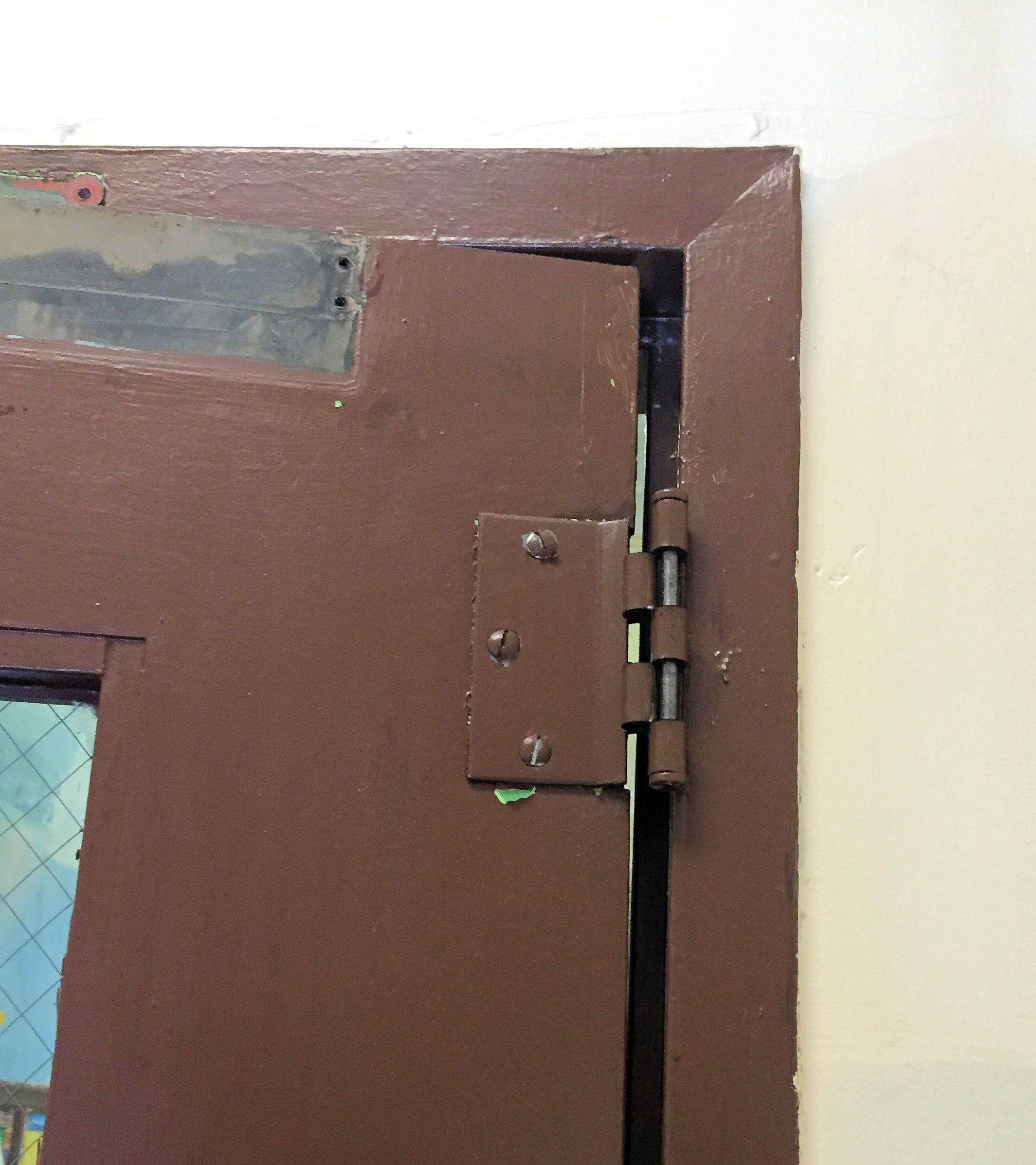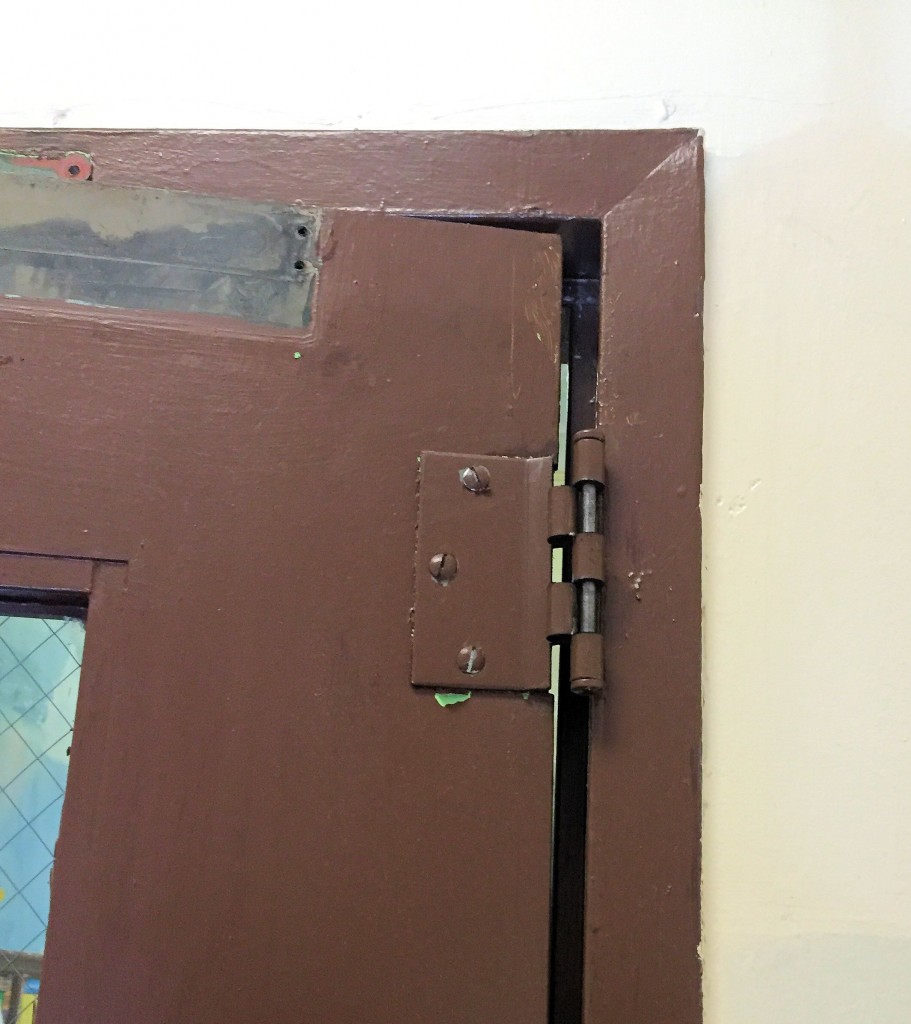Today’s Wordless Wednesday photo was sent by Nolan Thrope of Allegion…this is a cross-corridor fire door in a school. The closer is missing as well as the obvious hinge problem. Sadly, this type of neglect is not uncommon. 🙁
THIS is why the requirement for fire door inspections MUST be enforced. If a state has adopted the 2009 edition of the International Fire Code, or the 2009 edition of NFPA 1, NFPA 101, or a later edition of any of these codes, annual inspections of fire door assemblies are required unless the reference to maintenance in accordance with NFPA 80 has been purposely deleted. If an AHJ is not enforcing the requirements for fire door inspections, I’d love to know why not.
You need to login or register to bookmark/favorite this content.







Did the hinge break or did they just miss? Plus it looks like the door was prep’d for standard mortised hinges.
I’m not sure but either way it’s depressing!
– Lori
I can automate that door for you !
I’m sorry, Lori, but the code might as well require pigs to fly. There are seventy-bazillion-jillion doors for every qualified inspector. Heck, they can’t even keep up with elevators, never mind doors.
Best,
mwm
Hi Marcus –
So why do the codes bother with requiring fire doors if there is no verification that they are installed properly and no expectation that they will be maintained in operable condition? I don’t think the huge installed base is a good excuse for giving up on the value of the protection provided by fire door assemblies. The annual inspection requirement is being enforced in some jurisdictions, and some facilities are being proactive even if the requirements are not being enforced. I’m optimistically hopeful. 🙂
– Lori
I think what’s needed is a combination of public awareness and a means by which people who see problems can drive positive action. While it’s all well and good to say that all code violations should be fixed, in reality that isn’t always practical especially in areas which are prone to vandalism. Forcing a building owner to divert $1,000 away from other important things like security staff, for purposes of repairing and recertifying a fire door closer which will likely get broken again within a week, doesn’t seem like a very positive course of action.
I appreciate that in cases where a building owner can afford to install magnetic hold-opens which are wired in with the building’s alarm system, that’s often the best approach, but not all building owners can afford such things. While I appreciate that closers with thermal-link hold-opens aren’t as safe as magnetic hold-opens, I would think such a thing would still be vastly superior to closers which operate for a few days without such a feature before being vandalized and ceasing to work altogether.
I wonder if it might be good to have buildings publicly post “Fire-safety grades” similar to the “health-department grades” found in some cities. To achieve the highest grade, doors which would be used for moving furniture or other such purposes would need magnetic hold-open devices (on the presumption that if no hold-open devices are provided users are likely to temporarily or permanently disable the closers). Thermal-link hold-open devices would be recognized as being inferior to magnetic hold-opens, but still better than nothing.
Maybe the facility’s letter grade could affect their insurance premiums. 🙂
– Lori
All it would take to correct these deficiencies is accountability and media attention to the results of that accountability. If a landlord were severely fined for violation, or sent to jail in the case of negligent death, things might begin to change. And, if inspections aren’t conducted as required by the rule, fines should come down there also on the part of the municipality.
You are correct in everything you say, nevertheless, for every door that’s done to code there are a thousand that aren’t. And for every jurisdiction where annual inspections happen, there are an untold number where they don’t. While the photos that you and your contributors post on the amazing site are sometimes funny, sometimes sad, and sometimes scary, we see this stuff over and over and over, and it’s my feeling that AHJs in general don’t pay much attention to it. The code requirements are based on safety, security, and a good faith effort from the customer and the customer’s service company. Far too often, budget is more important to them than safety. Even if an AHJ is driven to uphold the code, there are far to many doors, and far too few inspectors. Hospitals and hotels do a better job than most facilities, but even here I have seen Rube Goldberg solutions to serious door issues. I know of a major hotel in a large metropolitan area where the corridor fire doors are from the 1920s or 30s, grandfathered in, I guess. (The last time I was there, anyway.) They are supposed to be closed by a pulley and weight system, and I’m not sure the doors could be moved with a crow bar. I’m not saying it’s right, and I’m not saying it’s okay, I’m just saying it is.
Those look like plain bearing hinges.
I think you’re right!
– Lori
I see this all the time.
Sadly many budgets don’t “allow” for a proper repair.
Not that I’m against fire door inspections at all, but is it realistic to think that every fire rated assembly in a city can be inspected annually? That would take an enormous amount of people to accomplish.
I don’t know if there will ever be enough certified fire door inspectors, but many facilities have their own people who are capable of conducting these inspections. A lot hospitals are already there, some universities are starting. Schools are tough because they often neglect the visible problems, so it’s unlikely they’ll be proactive unless they’re forced to. I see a huge need in multi-family buildings and hotels, because of the condition of many of these facilities. Our industry needs the ability to train more people to conduct the inspections. They don’t need to be AHCs…a good basic understanding of doors and hardware and some training on the code requirements would go a long way toward improving the existing conditions. Facilities have always been required to keep their fire door assemblies code-compliant. Because many did not maintain their doors properly, the inspection requirement was added. It’s really less about the inspection and more about fire doors that will function properly when needed.
– Lori
This door has wire glass in the lite-kit also. I hate to see this glass still around – especially in schools.
I agree. Unfortunately it’s difficult to get existing facilities to address it.
– Lori
It is not the responsibility for a Fire Inspector / Fire Marshal / AHJ to do these inspections for every fire and smoke door in their jurisdiction.
IT’S UP TO THE BUILDING OWNER who can hand it down to their FACILITIES MANAGEMENT TEAM TO HAVE THEIR DOORS COMPLIANT!!!!
The inspection and repair of these doors needs to be documented. The evidence of compliance.
It is easier now for the AHJ such as Fire Inspector, Fire Marshal, Insurance Co., Liability Attorney, etc. to prove compliance. Not harder. Simply get the Fire Door Inspection Report from the building owner. It’s not the AHJ who is liable for the report, it’s the building owner.
It is all about liability. And the liability lays solely on the building owner.
That is the message of the NFPA-80.
Sorry for the caps.
If you look closely, that door is prepped for a full mortise hinge, so this is some kind of a quick-fix solution for a door that’s probably broken. But for the life of me, I can’t figure out why that hinge pin does not connect the two leaves. I’m curious about what the middle hinge looks like.
Building owners and facility managers (FMs) need to be made aware of – and trained – what is a fire door and why these items must be maintained. But understanding the ‘what’ and ‘why’ of fire doors is still a cost that all but the most proactive building owners and FMs aren’t going to willingly undertake … until there is a co$t of non-compliance.
Consider – we all should proactively manage our health – but many don’t – until something happens. The same applies to maintaining fire doors. Owners and FM’s won’t undertake the expense of maintaining – let alone documenting – fire door operation until there is a reason (i.e. financial incentive) to do so.
Everyone needs to understand: Fire door inspections in healthcare didn’t occur due to AHJ enforcement. There was FINANCIAL incentive. CMS (the payor for medicare and medicaid), via NFPA 101, established a need for fire doors to comply with NFPA 80 requirements – or payments to hospitals for services rendered would be reduced. Then the Joint Commission – in their annual inspections – required proof via documentation of fire door compliance. Suddenly, fire door inspection and maintenance was no longer a COST, but a means to establish (or maintain) INCOME. There was FINANCIAL incentive.
The same is going to be required in the commercial segment. Until property owners and FMs experience a monetary incentive (thru a cost of non-compliance), moving fire door maintenance to the forefront is going to be a long and arduous process.
DHI’s Door Security and Safety Foundation, along with NFPA and ICC, have done a great job establishing the importance and requirement for proper fire door maintenance and documentation (in NFPA 80, NFPA 101, IBC and IFC). And they’ve produced a number of well trained inspectors (myself included). But now I feel the industry is looking to the wrong people to make it happen. We’re promoting a “grassroots” campaign – tasking enforcement at the local AHJ level. And wondering why it doesn’t happen. The campaign needs to be taken to the next level – to those who can create a FINANCIAL incentive for compliance, namely property insurance companies.
Insurance companies have risk mitigation instructors who train their insureds on avoiding risks. Insurance companies also have risk mitigation experts who annually review facilities to look for risks and determine cost of insurance. Let’s face it – money talks. If an insurance company reviewed a facility and identified malfunctioning fire doors as a risk, then underwriters took this into account by assessing a surcharge or penalty on insurance policy premiums, and communicated this to the insured, then fire door maintenance and documentation would become important to the owner and FM, elevating the issue from purely a cost to an avoidable penalty.
In summary, instead of looking to the AHJ to enforce fire door inspections, and wondering why it doesn’t happen, DHI and DSSF need to take the campaign to property insurance companies by training them on the issues. Once a property owner or FM understands proper fire door maintenance has a FINANCIAL INCENTIVE and ROI, only then will inspection and maintenance of fire doors experience widespread adoption. After all, isn’t that what we want – properly functioning fire doors that potentially save lives and property?
Hi David –
I agree with you, but I don’t know how to make this happen. I’ve talked to insurance companies and it’s hard to get them interested.
– Lori